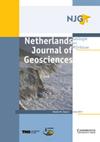罗尔谷地堑及其邻近地块中新世至上新世早期地层格架的更新和修正
IF 2.3
2区 地球科学
Q3 GEOSCIENCES, MULTIDISCIPLINARY
Netherlands Journal of Geosciences-Geologie En Mijnbouw
Pub Date : 2020-01-13
DOI:10.1017/njg.2019.10
引用次数: 19
摘要
在荷兰,大部分中新世至上新世晚期的沉积演替目前被划分为一个单一的岩石地层单元,即布雷达组。虽然该地层是在40多年前引入的,但其上下边界的定义仍然存在问题。测井对比表明,Groote Heide井的Breda组改进的lecto-层型与附近Broekhuizenvorst井的旧Veldhoven组的附加参考剖面部分重叠。布雷达组和上覆的奥斯特豪特组之间的区别主要基于海绿石和软体动物的数量差异,这引起了持续的讨论,特别是由于两个组中海绿石含量的浓度不同。此外,布雷达组缺乏一个区域尺度的地层格架,将其各种区域或局部定义的浅海与大陆成员联系起来。为了解决这些问题,我们对几个存档岩芯的材料进行了重新分析。将已存档的和新的dinocyst分析结果与多口井(包括Groote Heide井和Broekhuizenvorst井)的岩性描述和电缆测井相关性相结合。在此过程中,使用了Munsterman & Brinkhuis(2004)更新的dinocyst分区,并重新校准为Ogg等人(2016)的地质时间尺度。为了建立区域一致的岩石地层边界,研究人员使用了从Roer谷地堑中部(St-Michielsgestel-1井)到南部裂谷肩(Goirle-1井)的横断面的附加数据。沿着这条样带,将年代地层和岩石地层分析与测井对比和地震反射数据分析相结合,以约束几何/构造关系。结果表明,该地区划分出两个不同的地震序列,并有三个可识别的不整合面:早中新世不整合面(EMU)、中中新世不整合面(MMU)和晚中新世不整合面(LMU)。主要的区域性断陷,被称为中中新世不整合,发生在现在的布雷达组中,并迫使该单元细分为两个组,即此处新建立的格鲁特Heide组和更年轻的迪森组。在进一步研究之前,前Breda组将暂时提升到新成立的Hilvarenbeek组,其中包括Groote Heide组和Diessen组。虽然这两个层序已经在当地得到了定义,但LMU上的第三个层序代表了两个新定义的岩石地层单元,分别命名为Goirle和Tilburg成员,位于Oosterhout组的底部。除了其独特的岩性特征外,在地震反射剖面中,Goirle和Tilburg成员因其独特的地震相而引人注目。利用综合的、多学科的和区域性的方法,对荷兰提出了一个改进的北海南部框架和更全面的新近系岩石地层细分,以便在未来更直接地进行(跨界)对比。本文章由计算机程序翻译,如有差异,请以英文原文为准。
An updated and revised stratigraphic framework for the Miocene and earliest Pliocene strata of the Roer Valley Graben and adjacent blocks
Abstract In the Netherlands, the bulk of the Miocene to lowest Pliocene sedimentary succession is currently assigned to a single lithostratigraphical unit, the Breda Formation. Although the formation was introduced over 40 years ago, the definition of its lower and upper boundaries is still problematic. Well-log correlations show that the improved lecto-stratotype for the Breda Formation in well Groote Heide partly overlaps with the additional reference section of the older Veldhoven Formation in the nearby well Broekhuizenvorst. The distinction between the Breda and the overlying Oosterhout Formation, which was mainly based on quantitative differences in glauconite and molluscs, gives rise to ongoing discussion, in particular due to the varying concentrations of glauconitic content that occur within both formations. In addition, the Breda Formation lacks a regional-scale stratigraphic framework which relates its various regionally to locally defined shallow marine to continental members. In order to resolve these issues, we performed renewed analyses of material from several archived cores. The results of archived and new dinocyst analyses were combined with lithological descriptions and wire-line log correlations of multiple wells, including the wells Groote Heide and Broekhuizenvorst. In this process, the updated dinocyst zonation of Munsterman & Brinkhuis (2004), recalibrated to the Geological Time Scale of Ogg et al. (2016), was used. To establish regionally consistent lithostratigraphic boundaries, additional data was used along a transect across the Roer Valley Graben running from its central part (well St-Michielsgestel-1) towards the southern rift shoulders (well Goirle-1). Along this transect, chronostratigraphic and lithostratigraphic analyses were integrated with well-log correlation and the analyses of seismic reflection data to constrain geometrical/structural relationships as well. The results led to the differentiation of two distinct seismic sequences distinguished by three recognisable unconformities: the Early Miocene Unconformity (EMU), the Mid-Miocene Unconformity (MMU) and the Late Miocene Unconformity (LMU). The major regional hiatus, referred to as the Mid-Miocene Unconformity, occurs intercalated within the present Breda Formation and compels subdivision of this unit into two formations, viz. the here newly established Groote Heide and the younger Diessen formations. Pending further studies, the former Breda Formation will be temporally raised in rank to the newly established Hilvarenbeek subgroup, which comprises both the Groote Heide and Diessen formations. Whereas these two sequences were already locally defined, a third sequence overlying the LMU represents two newly defined lithostratigraphical units, named the Goirle and the Tilburg members, positioned in this study at the base of the Oosterhout Formation. Besides their unique lithological characteristics, in seismic reflection profiles the Goirle and the Tilburg members stand out because of their distinct seismic facies. Use of an integrated, multidisciplinary and regional approach, an improved southern North Sea framework and more comprehensive lithostratigraphic subdivision of Neogene successions is proposed for the Netherlands, to make (cross-border) correlations more straightforward in the future.
求助全文
通过发布文献求助,成功后即可免费获取论文全文。
去求助
来源期刊
CiteScore
4.00
自引率
25.90%
发文量
14
审稿时长
>12 weeks
期刊介绍:
Netherlands Journal of Geosciences - Geologie en Mijnbouw is a fully open access journal which publishes papers on all aspects of geoscience, providing they are of international interest and quality. As the official publication of the ''Netherlands Journal of Geosciences'' Foundation the journal publishes new and significant research in geosciences with a regional focus on the Netherlands, the North Sea region and relevant adjacent areas. A wide range of topics within the geosciences are covered in the journal, including "geology, physical geography, geophyics, (geo-)archeology, paleontology, hydro(geo)logy, hydrocarbon exploration, modelling and visualisation."
The journal is a continuation of Geologie and Mijnbouw (published by the Royal Geological and Mining Society of the Netherlands, KNGMG) and Mededelingen Nederlands Instituut voor Toegepaste Geowetenschappen (published by TNO Geological Survey of the Netherlands). The journal is published in full colour.

 求助内容:
求助内容: 应助结果提醒方式:
应助结果提醒方式:


